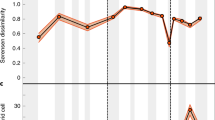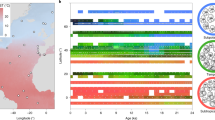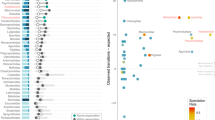Abstract
The latitudinal diversity gradient (LDG) is a prevalent feature of modern ecosystems across diverse clades1,2,3,4. Recognized for well over a century, the causal mechanisms for LDGs remain disputed, in part because numerous putative drivers simultaneously covary with latitude1,3,5. The past provides the opportunity to disentangle LDG mechanisms because the relationships among biodiversity, latitude and possible causal factors have varied over time6,7,8,9. Here we quantify the emergence of the LDG in planktonic foraminifera at high spatiotemporal resolution over the past 40 million years, finding that a modern-style gradient arose only 15 million years ago. Spatial and temporal models suggest that LDGs for planktonic foraminifera may be controlled by the physical structure of the water column. Steepening of the latitudinal temperature gradient over 15 million years ago, associated with an increased vertical temperature gradient at low latitudes, may have enhanced niche partitioning and provided more opportunities for speciation at low latitudes. Supporting this hypothesis, we find that higher rates of low-latitude speciation steepened the diversity gradient, consistent with spatiotemporal patterns of depth partitioning by planktonic foraminifera. Extirpation of species from high latitudes also strengthened the LDG, but this effect tended to be weaker than speciation. Our results provide a step change in understanding the evolution of marine LDGs over long timescales.
This is a preview of subscription content, access via your institution
Access options
Access Nature and 54 other Nature Portfolio journals
Get Nature+, our best-value online-access subscription
$29.99 / 30 days
cancel any time
Subscribe to this journal
Receive 51 print issues and online access
$199.00 per year
only $3.90 per issue
Buy this article
- Purchase on Springer Link
- Instant access to full article PDF
Prices may be subject to local taxes which are calculated during checkout




Similar content being viewed by others
Data availability
All data to reproduce our analyses are provided in https://doi.org/10.6084/m9.figshare.21355467. The spatiotemporal planktonic foraminiferal occurrence data were derived from Triton, an open-source database32.
Code availability
All code to reproduce the analyses is provided in https://doi.org/10.6084/m9.figshare.21355467. Our custom code relied on the following R packages: HH R package v.3.1-47, spatialreg R package v.1.2-3, geosphere R package, vegan R package v.2.5-7 and mapast R package v.0.1.
References
Fine, P. V. Ecological and evolutionary drivers of geographic variation in species diversity. Annu. Rev. Ecol. Evol. Syst. 46, 369–392 (2015).
Hillebrand, H. On the generality of the latitudinal diversity gradient. Am. Nat. 163, 192–211 (2004).
Mittelbach, G. G. et al. Evolution and the latitudinal diversity gradient: speciation, extinction and biogeography. Ecol. Lett. 10, 315–331 (2007).
Willig, M. R., Kaufman, D. M. & Stevens, R. D. Latitudinal gradients of biodiversity: pattern, process, scale, and synthesis. Annu. Rev. Ecol. Evol. Syst. 34, 273–309 (2003).
Pontarp, M. et al. The latitudinal diversity gradient: novel understanding through mechanistic eco-evolutionary models. Trends Ecol. Evol. 34, 211–223 (2019).
Crame, J. A. Taxonomic diversity gradients through geological time. Divers Distrib. 7, 175–189 (2011).
Mannion, P. D., Upchurch, P., Benson, R. B. J. & Goswami, A. The latitudinal biodiversity gradient through deep time. Trends Ecol. Evol. 29, 42–50 (2014).
Powell, M. G. Latitudinal diversity gradients for brachiopod genera during late Palaeozoic time: links between climate, biogeography and evolutionary rates. Glob. Ecol. Biogeogr. 16, 519–528 (2007).
Powell, M. G., Beresford, V. P. & Colaianne, B. A. The latitudinal position of peak marine diversity in living and fossil biotas. J. Biogeogr. 39, 1687–1694 (2012).
Hillebrand, H. Strength, slope and variability of marine latitudinal gradients. Mar. Ecol. Prog. Ser. 273, 251–267 (2004).
Beaugrand, G., Rombouts, I. & Kirby, R. R. Towards an understanding of the pattern of biodiversity in the oceans. Glob. Ecol. Biogeogr. 22, 440–449 (2013).
Tittensor, D. P. et al. Global patterns and predictors of marine biodiversity across taxa. Nature 466, 1098–1101 (2010).
Pianka, E. R. Latitudinal gradients in species diversity: a review of concepts. Am. Nat. 100, 33–46 (1966).
Saupe, E. E. et al. Spatio-temporal climate change contributes to latitudinal diversity gradients. Nat. Ecol. Evol. 3, 1419–1429 (2019).
Stehli, F. G., Douglas, R. G. & Newell, N. D. Generation and maintenance of gradients in taxonomic diversity. Science 164, 947–949 (1969).
Rutherford, S., D’Hondt, S. & Prell, W. Environmental controls on the geographic distribution of zooplankton diversity. Nature 4000, 749–752 (1999).
Klopfer, P. H. Environmental determinants of faunal diversity. Am. Nat. 93, 337–342 (1959).
Haffer, J. & Prance, G. T. Climatic forcing of evolution in Amazonia during the Cenozoic: on the refuge theory of biotic differentiation. Amazoniana 16, 579–607 (2001).
Dynesius, M. & Jansson, R. Evolutionary consequences of changes in species’ geographical distributions driven by Milankovitch climate oscillations. Proc. Natl Acad. Sci. USA 97, 9115–9120 (2000).
Dobzhansky, T. Evolution in the tropics. Am. Sci. 38, 209–221 (1950).
Williams, C. B. Patterns in the Balance of Nature (Academic Press, 1964).
Paine, R. T. Food web complexity and species diversity. Am. Nat. 100, 65–75 (1966).
Schemske, D. W., Mittelbach, G. G., Cornell, H. V., Sobel, J. M. & Roy, K. Is there a latitudinal gradient in the importance of biotic interactions? Annu. Rev. Ecol. Evol. Syst. 40, 245–269 (2009).
Currie, D. J. Energy and large-scale patterns of animal and plant species richness. Am. Nat. 137, 27–49 (1991).
Connell, J. H. & Orias, E. The ecological regulation of species diversity. Am. Nat. 98, 399–414 (1964).
Rosenzweig, M. L. Species Diversity in Space and Time (Cambridge Univ. Press, 1995).
Fenton, I. S. et al. The impact of Cenozoic cooling on assemblage diversity in planktonic foraminifera. Phil. Trans. R. Soc. B 371, 20150224 (2016).
Yasuhara, M. et al. Past and future decline of tropical pelagic biodiversity. Proc. Natl Acad. Sci. USA 117, 12891–12896 (2020).
Yasuhara, M., Hunt, G., Dowsett, H. J., Robinson, M. M. & Stoll, D. K. Latitudinal species diversity gradient of marine zooplankton for the last three million years. Ecol. Lett. 15, 1174–1179 (2012).
Jablonski, D., Roy, K. & Valentine, J. W. Out of the tropics: evolutionary dynamics of the latitudinal diversity gradient. Science 314, 102–106 (2006).
Yasuhara, M., Tittensor, D. P., Hillebrand, H. & Worm, B. Combining marine macroecology and palaeoecology in understanding biodiversity: microfossils as a model. Biol. Rev. 92, 199–215 (2017).
Fenton, I. S. et al. Triton, a new species-level database of Cenozoic planktonic foraminiferal occurrences. Sci. Data 8, 160 (2021).
Yasuhara, M. & Deutsch, C. A. Paleobiology provides glimpses of future ocean. Science 375, 25–26 (2022).
Yasuhara, M. et al. Time machine biology cross-timescale integration of ecology, evolution, and oceanography. Oceanography 33, 16–28 (2020).
Westerhold, T. et al. An astronomically dated record of Earth’s climate and its predictability over the last 66 million years. Science 369, 1383–1387 (2020).
Al-Sabouni, N., Kucera, M. & Schmidt, D. N. Vertical niche separation control of diversity and size disparity in planktonic foraminifera. Mar. Micropaleontol. 63, 75–90 (2007).
Lowery, C. M., Bown, P. R., Fraass, A. J. & Hull, P. M. Ecological response of plankton to environmental change: thresholds for extinction. Annu. Rev. Earth Planet. Sci. 48, 403–429 (2020).
Lear, C. H., Elderfield, H. & Wilson, P. A. Cenozoic deep-sea temperatures and global ice volumes from Mg/Ca in benthic foraminiferal calcite. Science 287, 269–272 (2000).
Weiner, A., Aurahs, R., Kurasawa, A., Kitazato, H. & Kučera, M. Vertical niche partitioning between cryptic sibling species of a cosmopolitan marine planktonic protist. Mol. Ecol. 21, 4063–4073 (2012).
Schneider, E. & Kennett, J. P. Segregation and speciation in the Neogene planktonic foraminiferal clade Globoconella. Paleobiology 25, 383–395 (1999).
Raja, N. B. & Kiessling, W. Out of the extratropics: the evolution of the latitudinal diversity gradient of Cenozoic marine plankton. Proc. Biol. Sci. 288, 20210545 (2021).
Allen, A. P. & Gillooly, J. F. Assessing latitudinal gradients in speciation rates and biodiversity at the global scale. Ecol. Lett. 9, 947–954 (2006).
Irigoien, X., Huisman, J. & Harris, R. P. Global biodiversity patterns of marine phytoplankton and zooplankton. Nature 429, 863–886 (2004).
Schiebel, R. & Hemleben, C. Planktic Foraminifers in the Modern Ocean (Springer-Verlag, 2017).
Ruddimann, W. F. Recent planktonic foraminifera: dominance and diversity in North Atlantic surface sediments. Science 164, 1164–1167 (1969).
Bé, A. W. H. & Tolderlund, D. S. in Micropaleontology of Marine Bottom Sediments (eds Funnell, B. M. & Riedel, W. K.) 105–149 (Cambridge Univ. Press, 1971).
Sibert, E., Norris, R., Cuevas, J. & Graves, L. Eighty-five million years of Pacific Ocean gyre ecosystem structure: long-term stability marked by punctuated change. Proc. Biol. Sci. 283, 20160189 (2016).
Chaudhary, C., Richardson, A. J., Schoeman, D. S. & Costello, M. J. Global warming is causing a more pronounced dip in marine species richness around the equator. Proc. Natl Acad. Sci. USA 118, e2015094118 (2021).
Worm, B. & Tittensor, D. P. A Theory of Global Biodiversity (Princeton Univ. Press, 2018).
Boscolo-Galazzo, F. et al. Temperature controls carbon cycling and biological evolution in the ocean twilight zone. Science 371, 1148–1152 (2021).
Boscolo-Galazzo, F. et al. Late Neogene evolution of modern deep-dwelling plankton. Biogeosciences 19, 743–762 (2022).
Aze, T. et al. A phylogeny of Cenozoic macroperforate planktonic foraminifera from fossil data. Biol. Rev. 86, 900–927 (2011).
Matthews, K. J. et al. Global plate boundary evolution and kinematics since the late Paleozoic. Glob. Planet. Change 146, 226–250 (2016).
Gyldenfeldt, A.-B. V., Carstens, J. & Meincke, J. Estimation of the catchment area of a sediment trap by means of current meters and foraminiferal tests. Deep Sea Res. Part II 47, 1701–1717 (2000).
Qiu, Z., Doglioli, A. M. & Carlotti, F. Using a Lagrangian model to estimate source regions of particles in sediment traps. Sci. China Earth Sci. 57, 2447–2456 (2014).
Siegel, D. A. & Deuser, W. G. Trajectories of sinking particles in the Sargasso Sea: modeling of statistical funnels above deep-ocean sediment traps. Deep Sea Res. Part I 44, 1519–1541 (1997).
Waniek, J., Koeve, W. & Prien, R. D. Trajectories of sinking particles and the catchment areas above sediment traps in the Northeast Atlantic. J. Mar. Res. 58, 983–1006 (2000).
R Core Team. R: A Language and Environment for Statistical Computing http://www.R-project.org (R Foundation for Statistical Computing, 2019).
Alroy, J. The fossil record of North American mammals: evidence for a Paleocene evolutionary radiation. Syst. Biol. 48, 107–118 (1999).
Marcot, J. D. The fossil record and macroevolutionary history of North American ungulate mammals: standardizing variation in intensity and geography of sampling. Paleobiology 40, 238–255 (2014).
Gaston, K. J., Williams, P. H., Eggleton, P. & Humphries, C. J. Large scale patterns of biodiversity: spatial variation in family richness. Proc. R. Soc. Lond. B 260, 149–154 (1995).
Valdes, P. J. et al. The BRIDGE HadCM3 family of climate models: HadCM3@Bristol v1.0. Geosci. Model Dev. 10, 3715–3743 (2017).
Cox, P. M. et al. The impact of new land surface physics on the GCM simulation of climate and climate sensitivity. Clim. Dyn. 15, 183–203 (1999).
Sagoo, N., Valdes, P., Flecker, R. & Gregoire, L. J. The Early Eocene equable climate problem: can perturbations of climate model parameters identify possible solutions? Phil. Trans. R. Soc. A 371, 20130123 (2013).
Kiehl, J. T. & Shields, C. A. Sensitivity of the Palaeocene–Eocene thermal maximum climate to cloud properties. Phil. Trans. R. Soc. A 371, 20130093 (2013).
Cox, M. D. A Primitive Equation, 3-Dimensional Model of the Ocean. GFDL Ocean Group Technical Report No. 1 (GFDL Princeton Univ., 1984).
Collins, M., Tett, S. F. B. & Cooper, C. The internal climate variability of HadCM3, a version of the Hadley Centre coupled model without flux adjustments. Clim. Dyn. 17, 61–81 (2001).
Farnsworth, A. et al. Climate sensitivity on geological timescales controlled by nonlinear feedbacks and ocean circulation. Geophys. Res. Lett. 46, 9880–9889 (2019).
Valdes, P. J., Scotese, C. R. & Lunt, D. J. Deep ocean temperatures through time. Clim. Past 17, 1483–1506 (2021).
Farnsworth, A. et al. Past East Asian monsoon evolution controlled by paleogeography, not CO2. Sci. Adv. 5, eaax1697 (2019).
Jones, L. A., Mannion, P. D., Farnsworth, A., Bragg, F. & Lunt, D. J. Climatic and tectonic drivers shaped the tropical distribution of coral reefs. Nat. Commun. 13, 3120 (2022).
Scotese, C. R. & Wright, N. PALEOMAP paleodigital elevation models (PaleoDEMS) for the Phanerozoic. Zenodo https://doi.org/10.5281/zenodo.5460860 (2018).
Foster, G. L., Royer, D. L. & Lunt, D. J. Future climate forcing potentially without precedent in the last 420 million years. Nat. Commun. 8, 14845 (2017).
Gough, D. O. Solar interior structure and luminosity variations. Sol. Phys. 74, 21–34 (1981).
Farnsworth, A. et al. Paleoclimate model-derived thermal lapse rates: towards increasing precision in paleoaltimetry studies. Earth Planet. Sci. Lett. 564, 116903 (2021).
Bahcall, J. N., Pinsonneault, M. H. & Basu, S. Solar models: current epoch and time dependences, neutrinos, and helioseismological properties. Astrophys. J. 555, 990–1012 (2001).
Hawkins, E. & Sutton, R. The potential to narrow uncertainty in regional climate predictions. Bull. Am. Meteorol. Soc. 90, 1095–1108 (2009).
Kraus, E. B. & Turner, J. S. A one-dimensional model of the seasonal thermocline II. The general theory and its consequences. Tellus 19, 98–105 (1967).
Foreman, S. J. The Ocean Model Report. Unified Model Documentaiton Paper Number 40 (The Met Office, 2005).
HH: Statistical Analysis and Data Display: Heiberger and Holland. R package version 3.1-47 (2022).
Zuur, A. F., Ieno, E. N. & Elphick, C. S. A protocol for data exploration to avoid common statistical problems. Methods Ecol. Evol. 1, 3–14 (2010).
Bivand, R., Millo, G. & Piras, G. A review of software for spatial econometrics in R. Mathematics 9, 1276 (2021).
Benjamini, Y. & Hochberg, Y. Controlling the false discovery rate: a practical and powerful approach to multiple testing. J. R. Stat. Soc. 57, 289–300 (1995).
Cooper, N. & Purvis, A. Body size evolution in mammals: complexity in tempo and mode. Am. Nat. 175, 727–738 (2010).
geosphere: Spherical Trigonometry. R package version 1.5-14 (2021).
Oksanen, J. et al. vegan: Community Ecology Package. R package version 2.5-7 (2020).
Wade, B. S., Pearson, P. N., Berggren, W. A. & Pälike, H. Review and revision of Cenozoic tropical planktonic foraminiferal biostratigraphy and calibration to the geomagnetic polarity and astronomical time scale. Earth Sci. Rev. 104, 111–142 (2011).
Acknowledgements
We thank A. Woodhouse, G. Antell, P. Hull, H. Johnson, H. Bouman and W. Kiessling for informative discussions; we are grateful to Triton and Neptune database contributors, from which Triton heavily draws. E.E.S. was supported by Leverhulme Trust grant RPG-201170, the Leverhulme Prize and the Natural Environment Research Council grant NE/V011405/1.
Author information
Authors and Affiliations
Contributions
E.E.S. conceptualized the study. E.E.S. and I.S.F. devised the methodology. I.S.F., E.E.S., A.F. and P.V. conducted the investigation. T.A., I.S.F. and E.E.S. performed visualization. E.E.S. acquired funding. E.E.S. conducted project administration. E.E.S. supervised the study. E.E.S. wrote the original draft of the manuscript. E.E.S., I.S.F., T.A., A.F. and P.V. reviewed and edited the manuscript.
Corresponding author
Ethics declarations
Competing interests
The authors declare no competing interests.
Peer review
Peer review information
Nature thanks Moriaki Yasuhara and the other, anonymous, reviewer(s) for their contribution to the peer review of this work.
Additional information
Publisher’s note Springer Nature remains neutral with regard to jurisdictional claims in published maps and institutional affiliations.
Supplementary information
Supplementary Information
This file contains Supplementary Figs. 1–44 and Supplementary Tables 1–4.
Rights and permissions
Springer Nature or its licensor (e.g. a society or other partner) holds exclusive rights to this article under a publishing agreement with the author(s) or other rightsholder(s); author self-archiving of the accepted manuscript version of this article is solely governed by the terms of such publishing agreement and applicable law.
About this article
Cite this article
Fenton, I.S., Aze, T., Farnsworth, A. et al. Origination of the modern-style diversity gradient 15 million years ago. Nature 614, 708–712 (2023). https://doi.org/10.1038/s41586-023-05712-6
Received:
Accepted:
Published:
Issue Date:
DOI: https://doi.org/10.1038/s41586-023-05712-6
This article is cited by
-
The emergence of modern zoogeographic regions in Asia examined through climate–dental trait association patterns
Nature Communications (2023)
-
Tropical biodiversity linked to polar climate
Nature (2023)
Comments
By submitting a comment you agree to abide by our Terms and Community Guidelines. If you find something abusive or that does not comply with our terms or guidelines please flag it as inappropriate.



